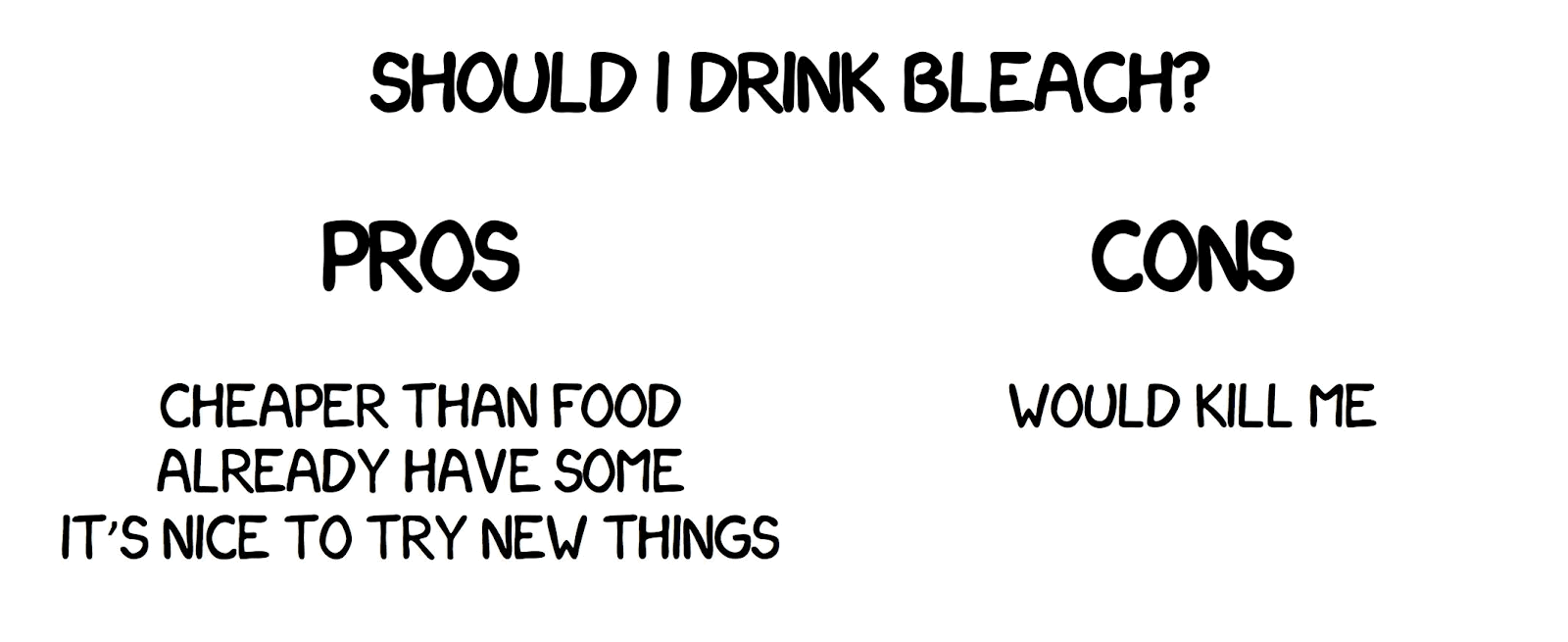How to make tough career decisions
Table of Contents
These decisions will affect how you spend years of your time, so the stakes are high. But they’re also an area where you shouldn’t expect your intuition to be a reliable guide. This means it’s worth taking a more systematic approach.
What might a good career decision process look like? A common approach is to make a pro and con list, but it’s possible to do a lot better. Pro and con lists make it easy to put too much weight on an unimportant factor. More importantly, they don’t encourage you to make use of the most powerful decision-making methods, which can greatly improve the quality of your decisions.

In this article, we present a step-by-step process for making your next career decision. This process draws on the most useful discoveries in decision-making research1 and our experience advising thousands of people one-on-one.
Career decisions usually involve a huge amount of uncertainty. If you sometimes feel stressed or anxious, this is normal. We can’t make your next decision easy, but if you work through this process, we think you’ll be more likely to avoid common mistakes and take the best next step you can.
You can work through the article below, or use a simplified version in our tool.

1. Clarify your decision
First, make sure you have a clear idea of exactly what decision you want to make. Are you choosing where to apply, between two specific offers, which medium-term options to focus on, or something else? When do you need to decide by?
Also note that this process is geared towards choosing between a list of specific options.

2. Write out your most important priorities
Once you’re clear about the next decision you need to make, write out your 4-7 most important priorities in making the decision. When making decisions, people usually focus on too narrow a set of goals. Writing out your list of factors will help you stay focused on what most matters.
We typically recommend that people focus on the factors in our framework, which we think capture most of the key elements in high-impact careers. They include the following:
- Career capital — does this option significantly accelerate you towards your longer-term career goals, or otherwise open up lots of good options?
- Impact potential — how pressing is the problem addressed and how large a contribution might the typical person in this career make to the problem (in expectation)?
- Personal fit — compared to the typical person in this career in the long-term, how productive do you expect to be?
- Personal satisfaction — how would this path satisfy other important personal priorities that aren’t already covered?
- Exploration value — might this path be an outstanding long-term option that you’re uncertain about and can test out?2
Which factors to focus on depends on the decision you’re making and your career stage.
If you’re earlier in your career and comparing longer-term options, you’ll probably mainly focus on impact potential, personal satisfaction, and fit.
If you’re comparing next steps (rather than longer-term options) and early in your career, then focus on career capital, exploration value, and fit.
If you’re later in your career and comparing next steps, you’d focus more on immediate impact and fit.
If working with a community, you might also consider:
- Relative fit — how do your strengths compare to other community members focusing on these issues (which determines your comparative advantage)?
- Community capital — does this increase the influence of the community and its ability to coordinate?
You can also try to make the factors more specific based on your situation. What type of career capital is most valuable? What signals best predict impact in the areas you’re focused on? What exactly are your priorities in personal satisfaction? On the latter, it’s important to try to be honest, even about your least noble motivations, or otherwise the path won’t be sustainable.
See a list of all the factors in our framework and a worksheet here.
There are also some other filters to consider:
- Do a significant number of people think this option is likely to have a negative impact in a top area? If so, can you modify the option to avoid the risk? If not, eliminate it. Read more about accidental harm.
- Does this option pose a significant risk of a long-term negative impact on your happiness or career capital? If so, modify it or eliminate it.

3. Generate more options
One of the most important mistakes when making career decisions is to consider too few options. Some research suggests that even just making sure you consider one extra option improves satisfaction with outcomes.
You probably already have some options in mind, but here the challenge is to generate even more.
One way to generate options is to use the priorities from the step before. What options might best help you achieve those priorities? For example, what might be the best option for career capital, job satisfaction, and so on?
You can generate longer-term options using our list of impactful skills to build and our list of impactful longer-term career paths.
If you’re trying to generate options for your next step (rather than long-term career), then it’s useful to both “work forwards” and “work backwards” to generate options.
Working backwards means starting from your longer-term vision and thinking about the most effective route to getting there.
Working forwards involves looking for great opportunities to learn and have an impact, even if you’re unsure where they’ll lead.
Here are some prompts for working forwards:
- Speak to your friends, those working on interesting problems, and people you admire, and ask about what might be a good fit for you.
- Check out the jobs listed on our job board — do any of them seem interesting?
- What options might you be unusually good at?
- What options might help you learn the most?
- What ‘open doors’ are available right now? These are interesting opportunities that you happen to have come across and might not be around in the future.
Here are even more prompts to help you come up with more options. Pick and choose whichever seem most useful to think about:
- Career capital — What’s the most valuable career capital you have right now? If I wanted to become excellent at a high-impact skill, how could I do that?
- Ideal world — What would you do if money were no object? What is your dream job?
- Combinations — Are there any ways your top options could be combined to get the best of all worlds?
- Elimination — If you couldn’t do any of your top options, what would you do instead?
You can get more advice on working forwards and backwards in our career guide article on career planning.

4. Rank your options
Now you’ve got your options on the table, put them in a rough order according to how well they satisfy the factors you wrote down at step two. Don’t worry too much about accuracy – we just want to get a rough idea at this stage to make it easier to do the next couple of steps.

5. List your key uncertainties
Try to identify the information that is most likely to change your ranking.
The questions people most commonly ask us are often not actually decision relevant. Frequently, people focus on big picture questions that are too hard to settle, so thinking about them is unlikely to change their ranking. It’s also easy to get lost ruminating about the huge variety of issues that can be relevant. Try to focus on the questions that are most relevant.
Some useful questions to consider include:
- How could you most easily rule out your top option?
- If you had to decide your career tomorrow for the rest of your life, what would you do today?
- What were you most uncertain about in making your ranking? Do any of those uncertainties seem easy to resolve?
Some of the most common questions are things like:
- Would I enjoy this job?
- Could I get this job?
- What skills are required to get this job?
- How pressing is this problem compared to other issues I could work on?
- How much influence would I really have in this position?
Try to make the questions as specific as possible.

6. Go and investigate
Not every decision in life deserves serious research, but career decisions do.
We often find people get stuck analysing their options, when it would be better to go and gather information or test out their options. For instance, we encountered an academic who wanted to take a year long sabbatical, but wasn’t sure where to go. They’d thought about the decision for a while, but hadn’t considered going to visit their top choice for a week, which would have likely made the decision a lot easier.
When investigating your options, we find it useful to think of a ladder of tests that go in ascending order of cost, and aim to settle the key uncertainties you’ve identified.
We often encounter people considering taking drastic action — like quitting their job — before taking lower cost ways to learn more about what’s best first.
Here’s an example of a ladder of tests:
- Read our relevant career reviews and do some Google searches to learn the basics (1-2h).
- Then the next most useful thing you can usually do is to speak to someone in the area. The right person can give you more up-to-date and personalised information than what you’ll be able to find written down (2h).
- Speak to three more people who work in the area and read one or two books (20h). You could also consider speaking to a careers adviser who specialises in this area. During this, also find out the most effective way for you to enter the area, given your background. Bear in mind that when you’re talking to these people, they are also informally interviewing you – see our advice on preparing for interviews in a later article.
- Now look for a project that might take 1-4 weeks of work, like applying to jobs, volunteering in a related role, or starting a blog on the policy area you want to focus on. If you’ve done the previous step, you’ll know what’s best.
- Only now consider taking on a 2-24 month commitment, like a work placement, internship or graduate study. At this point, being offered a trial position with an organisation for a couple of months can actually be an advantage, because it means both parties will make an effort to quickly assess your fit.
One of the most useful, but often neglected, steps is to simply apply to lots of jobs. We often find people wondering whether one path is better than another, when if they’d applied, it would have been obvious which one to go for.
If you’re lucky, at some point in these investigations, your next step will become clear.
If it doesn’t, then you can keep going up the ladder of tests until you run out of time, or perceive that your best guess about which option is best is no longer changing (technically, when the value of information is less than the cost of the test). One other rule of thumb is that the higher the stakes of the decision, the more time it’s worth investigating.
The aim is not confidence. You will likely always be uncertain about many aspects of your career. Instead, the aim is to find the best possible ranking using low-cost tests and basic research. Once you’ve done that, the most efficient way to learn more is probably to pick an option and try it out.

7. Make your final assessment
When you’ve finished investigating, it’s time to make a decision. Here are some more decision-making tips to help make your ranking more accurate.
Consider scoring your options
It can be useful to score your short-list of options on each of the factors listed in your second step from one to ten. There’s some evidence that making a structured decision like this can improve accuracy. It can be useful to add all your scores together and see what ranks highest. Don’t blindly use the score to determine your decision — it’s mainly a means of probing your thinking.
When it comes to assessing each factor, there are more tips on what to look for in our career framework article.
Upside downside analysis
If you want to go into more detail in making your assessment, then also consider imagining an upside and downside scenario for your top options to get a sense of the full range of possibilities (instead of thinking narrowly, which is the norm, and is especially misleading in the world of doing good, where often most of your impact comes from the small chance of an outsized success).
A simple way to do that is to consider a ‘success’ and ‘failure’ scenario for each. A more complex option is to consider:
- The upside scenario — what happens in a plausible best-case scenario? (To be more precise, that could be the top 5% of outcomes.)
- The downside scenario — what happens in a plausible worst-case scenario? (E.g. the worst 5% of outcomes.)
- The median — what’s most likely to happen?
In each scenario, consider how good or bad the option will be based on the factors you defined earlier — impact, career capital, learning and so on. One saving grace is that you often learn the most from failures, so the downside scenario is perhaps not as bad as it seems.
If you weight each scenario by their probability, you can make a rough estimate of the expected value of the option — this will often be dominated by the value of the upside scenario.
You may want to eliminate any options that have unusually large downsides. For instance, if you think pursuing an option might burn you out, bankrupt you, ruin your reputation, or holds another risk that could prevent you from making an impact in the future, it’s probably best to eliminate it so that you can ‘stay in the game’ and continue to have opportunities to contribute in the future. We talk more about Plan Z options later.
It’s also worth being very cautious about any course of action that might significantly set back your field, especially because these are easy to underestimate, and any options that seem harmful from a common sense perspective.
If you’re trying to decide which job to focus on for a couple of years, then a big part of your decision should be learning about what might be the best fit for you in the long term (value of information). This can mean it’s best to focus on the path with the best upside scenario rather than the best expected value (provided the downsides are similar). This is because if the upside scenario is realised, you can stick with it, and if it isn’t, you can switch to something else. This asymmetry means it’s rational to be somewhat optimistic.
Check your gut intuition
After you’ve finished your assessments, take a break, and re-rank your options.
Once you’ve made a ranking, notice if your gut intuition feels uneasy about something. You can’t simply go with your gut to make good career decisions, but you shouldn’t ignore your gut either. Your intuition is good at aspects of the decision where you’ve had lots of opportunity to practice with relatively quick feedback, such as whether the other people involved are trustworthy. But your intuition is not good at assessing novel situations, as many career decisions are.
If your gut feels uneasy, try to pinpoint why you’re having that reaction, and whether it makes sense to go with your gut or not in this instance. The ideal of good decision-making is to combine intuitive and systematic methods, and use the best aspects of each.
It’s also a good idea to sleep on it. This may help you process the information. It also reduces the chance that you’ll be unduly influenced by your mood at that moment.
More ways to reduce bias
If you want to go further, here are some other techniques to help reduce bias in your thinking:
- Ask yourself why you’re most likely to be wrong about your ranking. This is one of the most useful tips to reduce bias.
- Pre-mortem and pre-party: Imagine that you take an option, but two years later you’ve failed and regret the decision — what went wrong? Then imagine that instead the option was way better than you expected — what happened? This helps to expand your views about what’s possible, which tend to be too narrow.
- Change the frame. Imagine you’ve already made the decision, how do you feel? How do you expect to feel one year later? What about 10 years later? What would you advise a friend to do?
- Ask other people. Having to justify your reasoning to someone else can quickly uncover holes. You can also ask people where they think you’re most likely to be wrong.
More advanced decision-making techniques
There is much more to say about how to make good decisions. For instance, often decisions come down to predictions, especially about your likely chances of success in an area, and the expected impact of different interventions.
For instance, to make better predictions, you can make base-rate forecasts from many angles, combining them based on their predictive power. You should try to update on your evidence in a ‘bayesian’ way. You can break down the prediction into multiple components as a ‘fermi estimate’. And you can try to improve your calibration through training.
Here is some further reading we recommend on decision-making:
- 5 frameworks for prioritising by Lynette Bye
- Our podcast with Spencer Greenberg on bayesian updating and forecasts.
- Our podcast with Philip Tetlock on making good predictions, based on his excellent book, Superforecasting.
- Our summary of research on how to improve your judgement.
- Two popular books that go more into depth on the technique we’ve covered are Decisive by Chip and Dan Heath and The Signal in the Noise by Nate Silver.
- Clearer Thinking has many interactive tools to help you think through key decisions.
- How to measure anything by Douglas Hubbard.
Here is some more advanced reading:
- How to combine multiple forms of evidence: Model combination and adjustment by Luke Muehlhauser; Many Weak Arguments by Jonah Sinick; Sequence thinking vs. Cluster Thinking by Holden Karnofsky.
- When to defer to common sense: Common sense as a prior by Nick Beckstead; Inadequacy and Modesty by Eliezer Yudkowsky; In defence of epistemic modesty by Greg Lewis.
- Value-focused thinking by Ralph Keeney.

8. Make your best guess, and then prepare to adapt
At some point, you’ll need to make a decision. If you’re lucky, one of your options will be clearly better than the others. Otherwise, the decision will be tough.
Don’t be too hard on yourself: the aim is to make the best choice you can given the evidence available. If you’ve been through the process above then you have put yourself in a position to make a well-considered decision.
Here are some further steps you can take to reduce downsides.
Plan B
First, create a backup plan if your top choice doesn’t work out.
- Why is your top option most likely not to work out?
- What will you do in this situation? List any promising nearby alternatives to plan A, and call them your ‘plan B’. For instance, if you’re already in a job and applying to a masters programme, one possibility is that you don’t get into the programmes you want. In that case, your Plan B might be to stay in your job another year.
- We often cover nearby alternatives and ‘exit options’ in our skill pages, career reviews, and profiles on priority paths.
Consider how to order your options
When doing the above exercise, you might realise it’s much easier to switch from option X to Y, than from Y to X i.e. that option X is more reversible than Y.
For instance, after completing a PhD, everyone in academia agrees that if you leave, it’s hard to re-enter. This is because getting a permanent academic position is very competitive, and any sign that you’re not committed will rule you out (especially in certain subjects). This means that if you’re unsure about continuing with academia after your PhD, it’s often best to continue.
If you haven’t started a PhD, and want to try something else, then it’s best to do that before you start.
It can sometimes be better to enter the more reversible option, even if you’re less confident it’s best. If you’re right and it doesn’t work out, you can go back to your top option later anyway.
Ask yourself whether thinking about ordering should cause you to rerank your options.
Plan Z
You may face unforeseen setbacks, so it’s also useful to figure out a ‘Plan Z’. Here are some questions to help you do that.
- If you take your top option, what might the worst case scenario be? Many risks are not as bad as they first seem, but pay attention to anything that could permanently reduce your happiness or career capital.
- How can you reduce the chances of the worst case happening? It’s difficult to give general advice, but there are often ways to mitigate the risks.
- If the worst case scenario does happen, what will you do to cope? Call this your ‘Plan Z’. Some common options include: taking a temporary job to pay the bills, moving back in with your parents, or living off savings. What makes most sense will again depend a lot on your situation.
- Is your Plan Z tolerable? If not, then you should probably modify your plan A to build more career capital so that you’re in a better position to take risks (e.g. take a job that lets you save more money). If it is, great – hopefully this exercise will make it easier to commit to your Plan A.
Set a review point
A final point to bear in mind is that your next career step is probably only a commitment for 1-4 years — building a career is a step-by-step process, not a one-off decision — and if you plan ahead to that next revision point, you’ll be better able to focus on your top option in the meantime, as well as be more prepared when it arrives. Here are some extra steps to consider:
- Schedule in a time to review your career in six months or a year. We made a career review tool to make it easier.
- Set check-in points. Make a list of signs that would tell you you’re on the wrong path, and commit to reassessing if those occur. For example, publishing lots of papers in top journals is key to success in academic careers, so you could commit to reassessing the academic path if you don’t publish at least one paper in a top journal before the end of your PhD.

9. Take action
Once your plan is set, it’s time to focus on execution. How to execute is not the main focus of this article, but here are some further resources.
First, translate your plan into very concrete next steps. Write out what you’re going to do and when you’ll do it. Setting ‘implementation intentions’ makes it significantly more likely you’ll follow through.
To get more ideas on how to increase your chances of success in a path:
- Check out our relevant skill pages and career reviews, which sometimes have a section on how to succeed in a path.
- Read our review of how to become happier and more productive in any job (including how to network)
- Read our summary of advice on how to get a job.
One of the most useful steps you can take is to team up with others who want to have an impact. There are many great communities out there, often focused around specific problems. Your first step should probably be to try to meet people in the communities most relevant to you.
We also helped to found the effective altruism community, which is a group of people who use evidence and reason to work out the best ways to have a positive impact. This community is not for everyone, but through it we’ve met some of the most impressive people we know. Find out more about how to get involved.
Notes and references
- Some of the sources we drew upon include the following, as well as those listed above:
Ariely, Dan. Predictably Irrational. New York: HarperCollins, 2008.
Arkes, Hal R., and Catherine Blumer. “The psychology of sunk cost.” Organizational behavior and human decision processes 35.1 (1985): 124-140.
Heath, Chip, and Dan Heath. Decisive: How to make better choices in life and work. Random House, 2013.
Hubbard, Douglas W. “How to measure anything.” Finding the Value of “Intangibles” in Business (2007).
Keeney, Ralph L., and Ralph L. Keeney. Value-focused thinking: A path to creative decisionmaking. Harvard University Press, 2009.
Kahneman, Daniel. Thinking, fast and slow. Macmillan, 2011.
Larrick, Richard P. “Broaden the decision frame to make effective decisions.” Handbook of principles of organizational behavior (2009): 461-480.
Tversky, Amos, and Daniel Kahneman. “Judgment under uncertainty: Heuristics and biases.” Science 185.4157 (1974): 1124-1131.↩
- If you assess your options in terms of what would happen in a plausible best case scenario, rather than just in terms of expected value, then value of information will already be somewhat captured. This is the ‘upper confidence interval’ algorithm discussed in our podcast with Brian Christian.↩